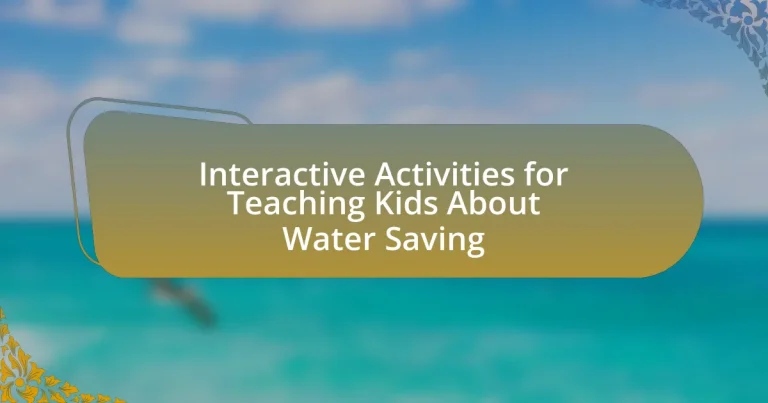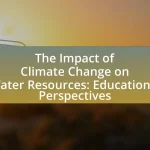The article focuses on interactive activities designed to teach children about water saving, emphasizing hands-on experiments, games, and creative projects that engage young learners. It highlights the effectiveness of experiential learning in enhancing children’s understanding and retention of water conservation concepts, supported by research indicating significant improvements in knowledge retention through interactive methods. The article also outlines various types of activities, such as water conservation games, DIY projects, and role-playing scenarios, while discussing the importance of tailoring these activities to different age groups and learning needs. Additionally, it addresses best practices for facilitators to create engaging learning environments and assess children’s understanding of water-saving concepts.
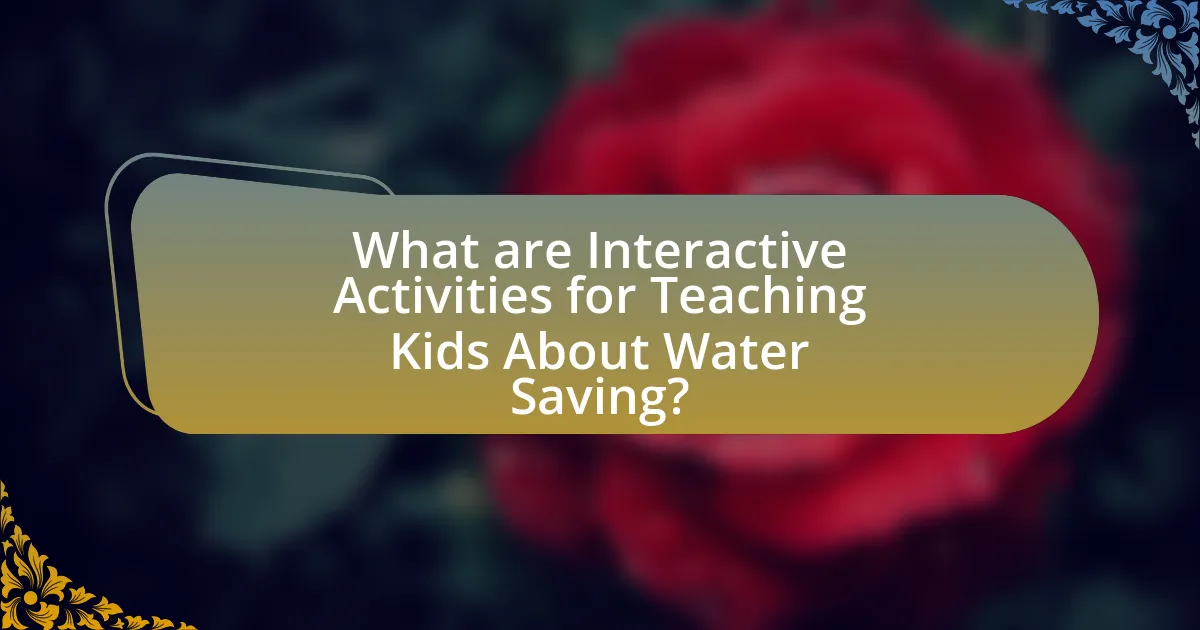
What are Interactive Activities for Teaching Kids About Water Saving?
Interactive activities for teaching kids about water saving include hands-on experiments, games, and creative projects that engage children in understanding the importance of conserving water. For example, conducting a water cycle experiment allows kids to visualize evaporation and condensation, reinforcing the concept of water conservation. Additionally, games like “Water Bingo” can teach children about water-saving practices in a fun way. Creative projects, such as designing posters that promote water-saving tips, encourage kids to express their understanding and share it with others. These activities not only educate but also foster a sense of responsibility towards water conservation.
How can interactive activities enhance children’s understanding of water conservation?
Interactive activities enhance children’s understanding of water conservation by engaging them in hands-on experiences that make the concept tangible and relatable. For instance, activities like water-saving challenges or interactive games can illustrate the impact of water usage in daily life, allowing children to see the consequences of waste firsthand. Research indicates that experiential learning, such as simulations or role-playing scenarios, significantly improves retention of information; a study published in the Journal of Environmental Education found that students participating in interactive lessons demonstrated a 30% increase in knowledge retention compared to traditional teaching methods. This evidence supports the effectiveness of interactive activities in fostering a deeper understanding of water conservation among children.
What types of interactive activities are most effective for teaching water saving?
Hands-on activities such as water conservation games, interactive workshops, and role-playing scenarios are most effective for teaching water saving. These activities engage participants actively, allowing them to experience the impact of water-saving practices firsthand. For instance, water conservation games can simulate real-life scenarios where participants must make decisions about water usage, reinforcing the importance of conservation. Research indicates that experiential learning, such as through workshops where children can measure water usage and implement conservation techniques, significantly enhances retention of water-saving concepts. A study published in the Journal of Environmental Education found that students who participated in interactive water-saving activities demonstrated a 30% increase in knowledge retention compared to traditional teaching methods.
How do these activities engage children in learning about water conservation?
Interactive activities engage children in learning about water conservation by providing hands-on experiences that illustrate the importance of saving water. For instance, activities like water-saving challenges or experiments demonstrate how much water can be wasted through everyday actions, making the concept tangible. Research shows that experiential learning increases retention; children are more likely to remember lessons about water conservation when they actively participate in related activities. Additionally, these activities often incorporate games and teamwork, fostering a collaborative environment that enhances understanding and encourages discussions about sustainable practices.
Why is it important to teach kids about water saving through interactive methods?
Teaching kids about water saving through interactive methods is important because it enhances engagement and retention of knowledge. Interactive methods, such as hands-on activities and games, allow children to experience the consequences of water waste firsthand, making the lessons more impactful. Research indicates that experiential learning can improve understanding and long-term memory retention by up to 75%, compared to traditional lecture-based methods. This approach not only fosters a sense of responsibility towards water conservation but also encourages critical thinking and problem-solving skills as children explore practical solutions to save water.
What are the long-term benefits of teaching children about water conservation?
Teaching children about water conservation leads to long-term benefits such as sustainable water usage and environmental stewardship. By instilling these values early, children develop habits that promote efficient water use, which can significantly reduce water waste over time. Research indicates that communities with a strong emphasis on water conservation education experience lower water consumption rates, contributing to the preservation of local ecosystems and resources. For instance, a study by the American Water Works Association found that educational programs targeting youth can lead to a 20% reduction in household water use when these children grow into adults. This demonstrates that early education on water conservation not only shapes individual behaviors but also fosters a culture of sustainability that benefits society as a whole.
How does early education on water saving impact future behaviors?
Early education on water saving significantly influences future water conservation behaviors. Children who receive instruction on the importance of water conservation are more likely to adopt sustainable practices as adults. Research indicates that individuals exposed to environmental education in their formative years demonstrate a higher likelihood of engaging in water-saving behaviors, such as reducing water usage and advocating for conservation efforts. A study published in the Journal of Environmental Education found that students who participated in water conservation programs showed a 30% increase in water-saving actions compared to those who did not receive such education. This evidence underscores the long-term impact of early education on fostering responsible water use habits.
What age groups benefit most from interactive water saving activities?
Children aged 5 to 12 benefit most from interactive water-saving activities. This age group is particularly receptive to hands-on learning experiences that engage their curiosity and creativity. Research indicates that children in this developmental stage are more likely to adopt sustainable behaviors when they participate in interactive activities, such as games or experiments that demonstrate water conservation techniques. For instance, a study published in the Journal of Environmental Education found that children who engaged in interactive water-saving programs showed a 30% increase in their understanding of water conservation practices compared to those who received traditional instruction.
How can activities be tailored for different age ranges?
Activities can be tailored for different age ranges by adjusting complexity, engagement methods, and learning styles. For younger children, activities should be simple, hands-on, and visually stimulating, such as interactive games or storytelling that illustrate water-saving concepts. For example, using colorful charts or puppets can effectively convey messages about water conservation.
In contrast, activities for older children can incorporate more complex problem-solving tasks, such as science experiments that demonstrate the effects of water waste or projects that involve creating water-saving plans for their homes. Research indicates that children aged 8-12 benefit from collaborative projects that encourage critical thinking and teamwork, enhancing their understanding of environmental issues.
By aligning activities with developmental stages, educators can ensure that the content is age-appropriate and engaging, fostering a deeper understanding of water conservation across various age groups.
What developmental milestones should be considered when designing these activities?
When designing interactive activities for teaching kids about water saving, developmental milestones such as cognitive, social-emotional, and physical development should be considered. Cognitive milestones include the ability to understand cause and effect, which is crucial for grasping the importance of water conservation. Social-emotional milestones involve developing empathy and responsibility, as children learn to care for resources and understand their impact on the environment. Physical milestones, such as fine motor skills, are important for engaging in hands-on activities like crafting or using tools to create water-saving devices. These milestones guide the design of age-appropriate activities that effectively engage children and enhance their learning experience.
How can parents and educators implement these activities effectively?
Parents and educators can implement interactive activities for teaching kids about water saving effectively by integrating hands-on projects that engage students in real-world applications. For instance, conducting water audits at home or school allows children to measure water usage and identify wasteful practices, fostering awareness and responsibility. Research indicates that experiential learning, such as participating in community clean-up events or creating water conservation posters, enhances retention of information and encourages proactive behavior towards environmental stewardship. By providing structured guidance and resources, parents and educators can facilitate meaningful discussions and reflections on water conservation, reinforcing the importance of sustainable practices in daily life.
What resources are available for creating interactive water saving activities?
Resources available for creating interactive water-saving activities include educational websites, community programs, and hands-on kits. Websites such as the U.S. Environmental Protection Agency (EPA) provide lesson plans and activity guides specifically designed for teaching water conservation. Community programs often offer workshops and events that engage children in water-saving practices through interactive games and challenges. Additionally, hands-on kits, like those from organizations such as WaterSense, include materials for experiments and activities that demonstrate the importance of water conservation. These resources are validated by their widespread use in educational settings and their alignment with environmental education standards.
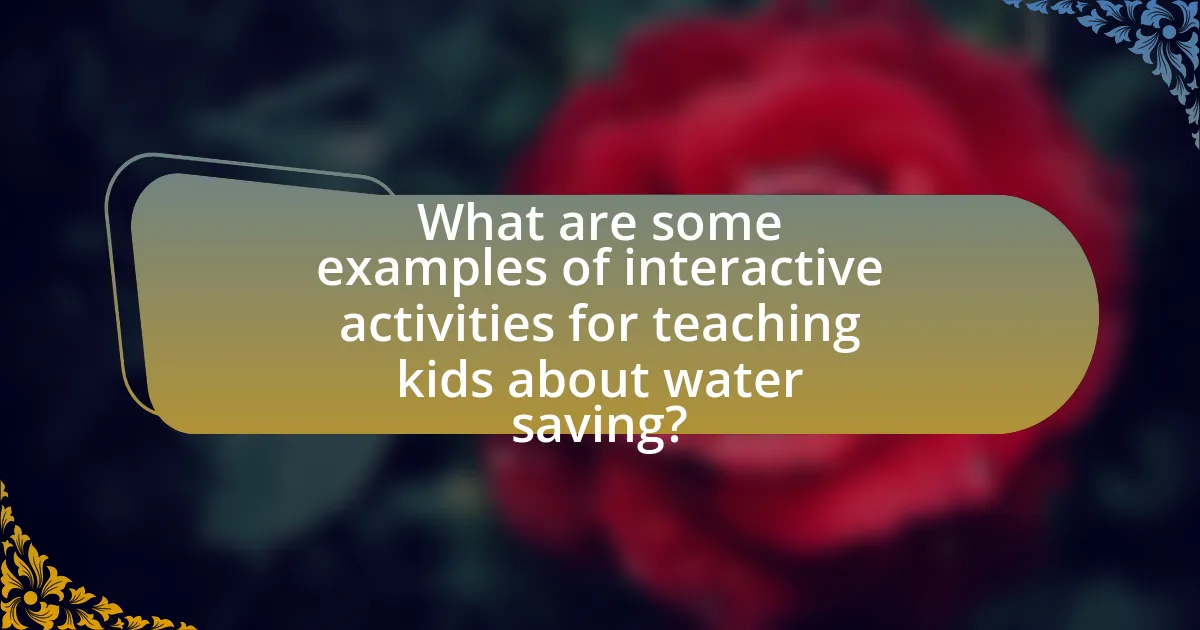
What are some examples of interactive activities for teaching kids about water saving?
Examples of interactive activities for teaching kids about water saving include water conservation games, DIY rainwater collection systems, and water usage tracking charts. Water conservation games, such as quizzes or board games, engage children in learning about the importance of saving water while making it fun. DIY rainwater collection systems allow kids to participate in hands-on projects that demonstrate how rainwater can be harvested and reused, fostering a practical understanding of water resources. Water usage tracking charts encourage children to monitor their daily water consumption, helping them identify areas where they can reduce usage. These activities not only educate but also empower children to take action in conserving water.
How can games be used to teach water conservation?
Games can be used to teach water conservation by simulating real-life scenarios where players must manage water resources effectively. These interactive experiences engage players in decision-making processes that highlight the importance of conserving water, such as managing a virtual farm or city where water scarcity impacts growth and sustainability. Research indicates that educational games can improve knowledge retention; for instance, a study published in the Journal of Educational Psychology found that game-based learning can enhance understanding of environmental issues, including water conservation, by up to 30%. This evidence supports the effectiveness of games as a tool for teaching critical concepts related to water saving.
What types of games are most engaging for children?
Interactive games that promote problem-solving and creativity are most engaging for children. Games such as role-playing scenarios, interactive storytelling, and hands-on science experiments capture children’s attention and encourage active participation. Research indicates that children are more likely to engage with games that incorporate elements of competition, collaboration, and real-world applications, such as water-saving challenges that require teamwork to solve environmental issues. For example, a study published in the Journal of Educational Psychology found that children who participated in interactive, game-based learning activities demonstrated higher levels of engagement and retention of information compared to traditional teaching methods.
How can competition enhance learning about water saving?
Competition can enhance learning about water saving by motivating individuals to engage actively in water conservation practices. When participants compete, they are more likely to adopt innovative strategies to reduce water usage, as evidenced by programs like the Water Conservation Challenge, which reported a 30% reduction in water consumption among participants. This competitive environment fosters collaboration and knowledge sharing, as individuals learn from each other’s successes and failures, ultimately leading to a deeper understanding of effective water-saving techniques.
What hands-on projects can children participate in to learn about water saving?
Children can participate in hands-on projects such as creating a rainwater harvesting system, building a mini water filtration system, and conducting water usage audits at home. These projects engage children in practical applications of water conservation techniques. For instance, a rainwater harvesting system allows children to understand how to collect and utilize rainwater for gardening, demonstrating the importance of conserving potable water. Building a mini water filtration system teaches them about the water cycle and the significance of clean water. Conducting water usage audits helps children analyze their water consumption patterns, fostering awareness of their impact on water resources. These activities not only educate but also empower children to take actionable steps towards water saving.
How can gardening projects teach kids about water usage?
Gardening projects can teach kids about water usage by providing hands-on experience in managing water resources for plant growth. Through activities such as measuring soil moisture, kids learn the importance of watering plants efficiently and the impact of overwatering. Research shows that children involved in gardening projects develop a better understanding of the water cycle and conservation practices, as they observe the direct relationship between water usage and plant health. For instance, studies indicate that children who participate in school gardening programs demonstrate increased awareness of sustainable practices, including the significance of using water wisely.
What DIY projects can illustrate the importance of water conservation?
DIY projects that illustrate the importance of water conservation include creating a rainwater harvesting system, building a simple drip irrigation system, and making a water-efficient garden. A rainwater harvesting system can collect and store rainwater for irrigation, demonstrating how to utilize natural resources effectively. A drip irrigation system can show how targeted watering reduces water waste compared to traditional methods. Additionally, a water-efficient garden can teach children about selecting drought-resistant plants and using mulch to retain soil moisture, reinforcing the concept of conserving water in landscaping. These projects provide hands-on experiences that highlight the significance of water conservation in everyday life.
How can storytelling and role-playing be incorporated into water saving education?
Storytelling and role-playing can be incorporated into water saving education by creating engaging narratives and scenarios that illustrate the importance of water conservation. For instance, educators can develop stories featuring characters who face challenges related to water scarcity, prompting students to explore solutions through role-playing activities. Research indicates that experiential learning, such as role-playing, enhances retention of information; a study by the National Science Foundation found that students who participated in role-playing exercises demonstrated a 30% increase in knowledge retention compared to traditional teaching methods. This approach not only makes learning about water conservation more relatable but also empowers students to take action in their own lives.
What themes should stories focus on to effectively convey water conservation messages?
Stories should focus on themes of responsibility, community action, and the impact of individual choices to effectively convey water conservation messages. Responsibility emphasizes the importance of each person’s role in conserving water, showcasing characters who make conscious decisions to save water in their daily lives. Community action highlights collective efforts, illustrating how groups can work together to implement water-saving initiatives, such as community gardens or clean-up events. The impact of individual choices can be demonstrated through narratives that show the consequences of water waste versus the benefits of conservation, reinforcing the idea that small actions lead to significant change. These themes resonate with audiences and encourage proactive behavior towards water conservation.
How can role-playing scenarios help children understand the impact of water waste?
Role-playing scenarios can help children understand the impact of water waste by immersing them in realistic situations where they must make decisions about water usage. Through these interactive experiences, children can visualize the consequences of their actions, such as the depletion of water resources or the effects on the environment. Research indicates that experiential learning, like role-playing, enhances retention of information; for instance, a study published in the Journal of Environmental Education found that students who engaged in role-playing activities demonstrated a 30% increase in knowledge retention regarding environmental issues compared to traditional teaching methods. This method not only fosters empathy but also encourages critical thinking about sustainable practices, making the concept of water conservation more relatable and impactful for young learners.
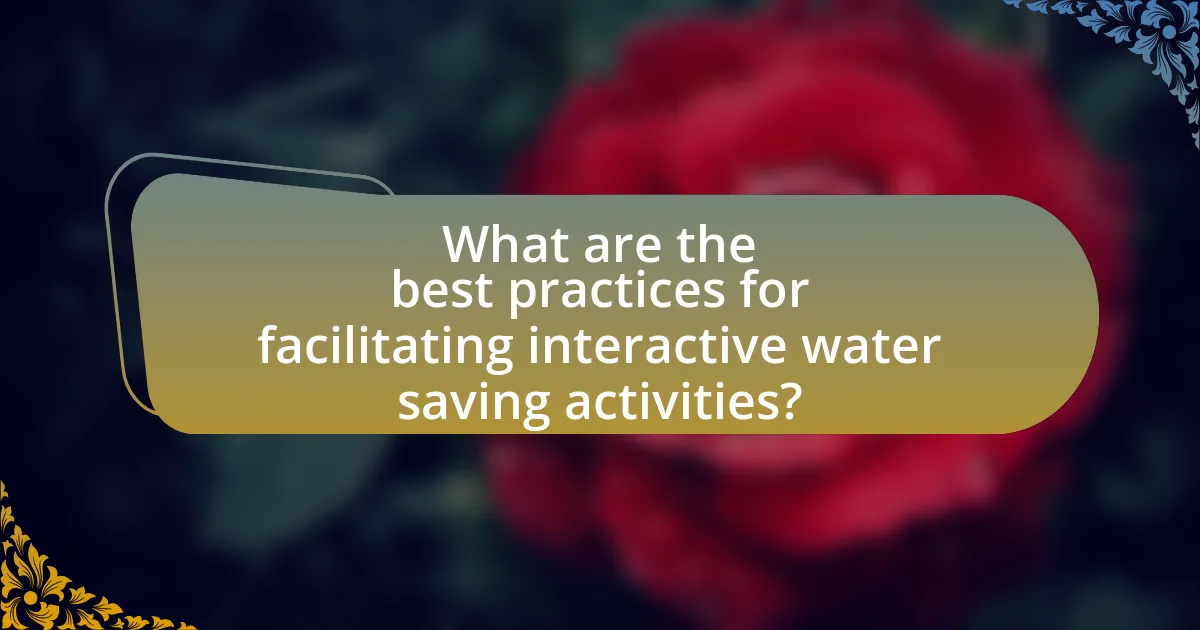
What are the best practices for facilitating interactive water saving activities?
The best practices for facilitating interactive water saving activities include engaging participants through hands-on experiences, using relatable scenarios, and incorporating educational games. Engaging participants actively helps them understand the importance of water conservation, as studies show that experiential learning increases retention of information. Using relatable scenarios, such as simulating a drought or water scarcity, allows participants to connect emotionally and recognize the real-world implications of water waste. Incorporating educational games, like water trivia or conservation challenges, fosters a fun learning environment while reinforcing key concepts about water saving. These methods have been shown to enhance understanding and promote lasting behavioral changes regarding water conservation.
How can facilitators create an engaging environment for learning?
Facilitators can create an engaging environment for learning by incorporating interactive activities that actively involve participants. For instance, hands-on experiments related to water conservation, such as measuring water usage or creating water-saving devices, can enhance engagement. Research indicates that experiential learning increases retention and understanding; a study by Kolb (1984) highlights that learners retain information better when they actively participate in the learning process. Additionally, facilitators can foster collaboration through group discussions and problem-solving tasks, which promote peer interaction and deeper learning. By utilizing these strategies, facilitators can effectively engage learners in the topic of water saving.
What techniques can be used to encourage participation and discussion?
Techniques to encourage participation and discussion include using open-ended questions, incorporating interactive activities, and creating a safe environment for sharing ideas. Open-ended questions stimulate critical thinking and invite diverse responses, fostering deeper engagement. Interactive activities, such as group projects or hands-on experiments related to water saving, promote collaboration and make learning enjoyable. Additionally, establishing a safe environment where children feel comfortable expressing their thoughts without judgment encourages more active participation. Research shows that environments that support open dialogue lead to increased involvement and retention of information, particularly in educational settings focused on practical topics like water conservation.
How can facilitators assess children’s understanding of water saving concepts?
Facilitators can assess children’s understanding of water saving concepts through interactive quizzes and hands-on activities. These methods allow facilitators to gauge comprehension by observing children’s responses and engagement levels. For instance, quizzes can include questions about specific water-saving practices, while activities like creating a water conservation poster can reveal children’s ability to apply concepts creatively. Research indicates that active participation enhances retention, making these assessment methods effective in evaluating understanding.
What common challenges might arise during interactive water saving activities?
Common challenges during interactive water saving activities include lack of engagement, misunderstanding of concepts, and logistical issues. Lack of engagement can occur when activities do not capture children’s interest, leading to minimal participation. Misunderstanding of concepts may arise if the activities are not age-appropriate or if instructions are unclear, resulting in confusion about the importance of water conservation. Logistical issues, such as insufficient resources or space, can hinder the execution of activities, making it difficult to effectively teach water-saving practices. These challenges can significantly impact the effectiveness of educational efforts aimed at promoting water conservation among children.
How can facilitators address resistance or lack of interest from children?
Facilitators can address resistance or lack of interest from children by incorporating engaging, hands-on activities that relate to their interests and experiences. For instance, using interactive games or experiments that demonstrate the importance of water conservation can capture children’s attention and make learning enjoyable. Research indicates that experiential learning increases engagement; a study by Kolb (1984) highlights that active participation enhances retention and interest in the subject matter. By tailoring activities to children’s preferences, facilitators can effectively reduce resistance and foster a positive learning environment focused on water saving.
What strategies can be employed to adapt activities for diverse learning needs?
To adapt activities for diverse learning needs, educators can employ differentiated instruction, which involves tailoring teaching methods and resources to accommodate various learning styles and abilities. This strategy includes providing multiple means of engagement, such as visual aids, hands-on activities, and collaborative group work, allowing students to interact with the material in ways that suit their preferences. Research by Tomlinson (2001) emphasizes that differentiated instruction can enhance student motivation and understanding by addressing individual strengths and challenges. Additionally, using formative assessments helps educators identify specific learning needs and adjust activities accordingly, ensuring that all students can participate meaningfully in lessons about water saving.
What tips can enhance the effectiveness of teaching kids about water saving?
To enhance the effectiveness of teaching kids about water saving, engaging them in interactive activities is crucial. Activities such as water conservation games, hands-on experiments demonstrating water usage, and creating art projects using recycled materials can make learning about water saving fun and memorable. Research shows that experiential learning increases retention rates; for instance, a study by the National Science Foundation found that students retain 75% of what they learn through hands-on experiences compared to only 5% through lectures. Additionally, incorporating storytelling about water scarcity and its impact can foster empathy and a deeper understanding of the importance of conservation.
